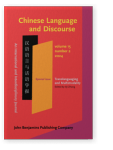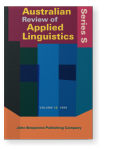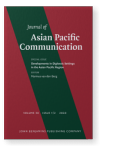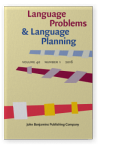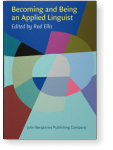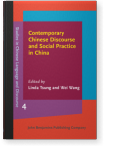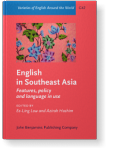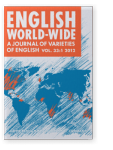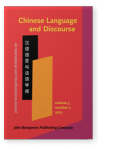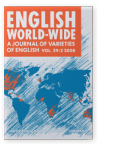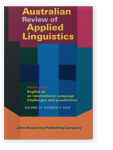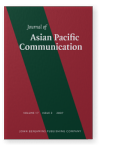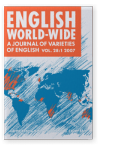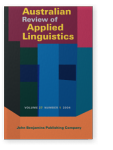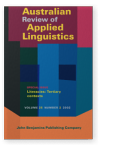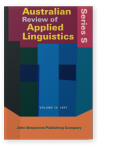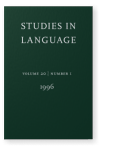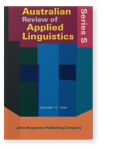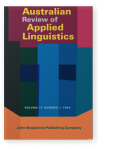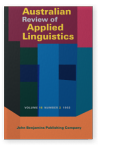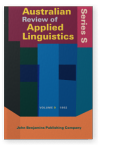Andy Kirkpatrick
List of John Benjamins publications for which Andy Kirkpatrick plays a role.
Journal
Title
The Hard Work–Entertainment Continuum: Teaching Asian languages in Australia
Edited by Andy Kirkpatrick, Yong Zhong and Helen Kirkpatrick
[Australian Review of Applied Linguistics. Series S, 12] 1995. vii, 283 pp.
Subjects Applied linguistics | Language acquisition | Language teaching
2020 Dimensions of language education policy in Asia Developments in Diglossic Settings in the Asian Pacific Region, Berg, Marinus van den (ed.), pp. 7–33 | Article
This paper will identify the major trends that can be determined from an overall study of recent language policies across Asia. The trends can be seen across three interrelated themes, namely: the promotion and privileging of one language as the national language as part of an attempt to create a… read more
2016 Foreign language policies in Asia and Australia in the Asian century Language Problems and Language Planning 40:1, pp. 26–46 | Article
This article provides a comparative analysis of foreign language policies in Asia and Australia with reference to policy contexts, motivations and processes. The analysis is specifically motivated by the recent publication of the Australia in the Asian Century White Paper that represents… read more
2016 Happenchance and Circumstance Becoming and Being an Applied Linguist: The life histories of some applied linguists, Ellis, Rod (ed.), pp. 231–252 | Article
2015 Foreword Contemporary Chinese Discourse and Social Practice in China, Tsung, Linda and Wei Wang (eds.), pp. xiii–xvi | Foreword
2014 Non-standard or new standards or errors? The use of inflectional marking for present and past tenses in English as an Asian lingua franca The Evolution of Englishes: The Dynamic Model and beyond, Buschfeld, Sarah, Thomas Hoffmann, Magnus Huber and Alexander Kautzsch (eds.), pp. 386–400 | Article
Using data of speakers whose first language is a variety of Malay, a language that does not mark for tense, this article will investigate the hypothesis that speakers of second language (L2) varieties of English whose first languages (L1s) do not mark for tense, will use tense marking less… read more
2012 Chapter 1. Theoretical issues English in Southeast Asia: Features, policy and language in use, Low, Ee-Ling and Azirah Hashim (eds.), pp. 13–32 | Chapter
The chapter begins with a discussion of the linguistic and sociolinguistic motivations that lead to the creation of distinctive linguistic features in new varieties of English. This will include a review of issues connected with language contact, nativisation and the nature of code-mixing. The… read more
2012 Mǎi dan or mái dan? ‘I come to buy the bill not to bury it’ Chinese Language and Discourse 3:2, pp. 227–246 | Article
The term maidan has become a common way of asking for the bill in Putonghua. In this paper we investigate whether this is the transfer of a Cantonese expression which has been re-interpreted as a Putonghua expression, and thus an example of language change being caused by a mistake or mishearing.… read more
2008 The pronunciation of Hong Kong English English World-Wide 29:2, pp. 148–175 | Article
This paper provides a detailed description of the pronunciation of English by fifteen fourth-year undergraduates at the Hong Kong Institute of Education. First, the occurrence of American features of pronunciation is considered. Then there is an analysis of the pronunciation of initial TH, initial… read more
2008 Learning English and other languages in multilingual settings: Principles of multilingual performance and proficiency English as an International Language: Challenges and possibilities, Clyne, Michael and Farzad Sharifian † (eds.), pp. 31.1–31.11 | Miscellaneous
2007 The Arrangement of Letters: Hierarchy or Culture? From Cicero to China Journal of Asian Pacific Communication 17:2, pp. 245–258 | Article
In this article I first discuss a genre of writing, the Ars Dictaminis, which became popular in Europe from the 11th century and which flourished in the 12th and 13th centuries. In particular I consider the arrangement of letters as advised in Ars Dictaminis treatises and show its influence from… read more
2007 Review of Adamson (2004): China’s English. A History of English in Chinese Education English World-Wide 28:1, pp. 123–127 | Review
2004 Medieval Chinese rules of writing and their relevance today Australian Review of Applied Linguistics 27:1, pp. 1–14 | Article
Chen Kui was a scholar-official of the Southern Song dynasty. He published the Wen Ze (here translated as The Rules of Writing) in 1170. This book is commonly described by Chinese scholars as China’s first systematic account of Chinese rhetoric. The book comprises ten chapters, covering aspects of… read more
2002 Cultures of learning: Critical reading in the social and applied sciences Literacies: Tertiary contexts, Golebiowski, Zosia, pp. 73–99 | Article
Australian university students are characterised in some quarters, and by employer groups especially, as lacking a high facility with literacy skills. But what literacy skills do students actually need for tertiary study in Australia today? What expectations do students and teachers have about… read more
1997 Using contrastive rhetoric to teach writing: Seven principles Teaching Languages, Teaching Culture, Liddicoat, Anthony J. and Chantal Crozet (eds.), pp. 89–102 | Article
1996 'Topic — Comment or Modifier — Modified? Information Structure in Modern Standard Chinese Studies in Language 20:1, pp. 93–113 | Article
In this paper we first summarise how linguists have treated the notions of topic and comment in the context of Chinese sentence structure. We then review how a number of Chinese scholars have analysed sentence structure in Chinese. We then propose that certain sentences in MSC traditionally… read more
1995 The teaching and learning of the four priority Asian languages The Hard Work–Entertainment Continuum: Teaching Asian languages in Australia, Kirkpatrick, Andy, Yong Zhong and Helen Kirkpatrick (eds.), pp. 17–34 | Article
1995 Foreword The Hard Work–Entertainment Continuum: Teaching Asian languages in Australia, Kirkpatrick, Andy, Yong Zhong and Helen Kirkpatrick (eds.), pp. i–iii | To be specified
1994 How do you know what i’m going to say? the use of advance organisers in modern standard Chinese Spoken Interaction Studies in Australia, Gardner, Rod (ed.), pp. 83–96 | Article
The use of advance organisers (Clyne 1987) are common in English. In this article, we divide advance organisers into two types – those that signpost the structure of the discourse for a listener and those that signpost the content of the discourse for the listener. Data of extended spoken… read more
1993 Information sequencing in Modern Standard Chinese Australian Review of Applied Linguistics 16:2, pp. 27–60 | Article
The hypothesis presented in this paper is that the sequence of ‘modifier-modified’ is a fundamental unit of sequencing in Modern Standard Chinese (MSC). It is shown that this sequencing unit extends beyond word pairs such as adjective-noun to sentences with complex clauses and also that it… read more
1992 Schemas, authentic texts and cross-cultural communication Language Teaching and Learning in Australia, Mann, Chris and Richard B. Baldauf, Jr. † (eds.), pp. 101–119 | Article
It is proposed that teaching and learning the schemas of language is important for effective language learning. In the first part of the paper, the cultural and linguistic interdependence of schemas is discussed. In the second part of the paper, 40 Chinese letters of request written by Mainland… read more
